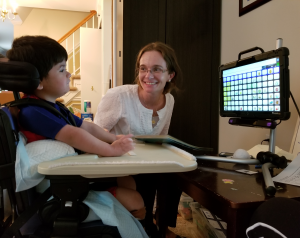 As we were reading Curious George and the Fire Fighters, Joey asked for a fire engine by saying “Fire engine” on his device and pointing to the box where I had small fire engine toys. I handed him one but he looked perturbed. “Different fire engine” he said. OK, got it, you want a different one. “Do you want big fire engine or little fire engine?” I asked in a mix of oral language and on his AAC device. He immediately looked around the room for the big fire engine, answering my question with his eye gaze.
As we were reading Curious George and the Fire Fighters, Joey asked for a fire engine by saying “Fire engine” on his device and pointing to the box where I had small fire engine toys. I handed him one but he looked perturbed. “Different fire engine” he said. OK, got it, you want a different one. “Do you want big fire engine or little fire engine?” I asked in a mix of oral language and on his AAC device. He immediately looked around the room for the big fire engine, answering my question with his eye gaze.
Recently, Joey’s use of language and reciprocal communication has made a developmental leap. He is putting more and more two and three-word phrases together, and is using a mix of his AAC, oral language, and gestures to maintain a rhythmic reciprocal communication with whoever he is talking with. It is exciting to witness.
At our last session he was able to use his device to ask for a specific book (he has almost all the words in the title of Duck on a Bike) and when I started reading too fast, he requested “slow read slow.” Later, when he was tired of working, he requested “Don’t work”.
In the past few years I’ve joined Facebook groups for parents and clinicians working with students on AAC devices (my favorite being Motivate, Model, Move Out of the Way). I love the ideas I get from these groups, but just the phrase of Motivate, Model, and Move Out of the Way is the perfect quick reminder of how to support Joey’s growing ability to use his AAC device. Initially we needed to motivate Joey to use it, because he’d previously had a strong communication system that was working for him, and he did not recognize how much it was limiting him. Now that he is excited to use his words and understands what the device can do, we’re in the model phase, where Joey is learning to use words and phrases to communicate with others.
One tip I was reminded of from reading posts in this group is how important it is to model using the AAC just above where the child is currently using the device. So, when a child says, “fire engine” we can model, “want fire engine”, while still acknowledging that the child used his device to request a fire engine. When the child using the AAC device says, “want fire engine” we can model up by saying, “You want fire engine”, to help him transition from two to three-word phrases. This is similar to when a typically developing child says “milk!” and as the mom goes to get him milk she says, “You want milk!” Much of the literature I’ve read on prompting and modeling with AAC devices recommends not dictating which words the child should use, but instead modeling the words and offering suggestions on what “some people may say.”
As Joey’s language continues to grow, I am constantly asking myself if I am scaffolding my modeling to support his upward trajectory. Am I building three to four-word phrases on his device when I am talking with him? Am I using the device to communicate for different reasons, beyond simply labeling things in the environment or making requests? Am I using a variety of vocabulary words, or am I sticking to ones I know how to find?
Joey reminded me to increase my AAC vocabulary use during our last session while we were reading Curious George and the Fire Fighters. As I was reading about how the fire fighters were getting dressed, I used the device to label “big black” and then orally said hat. Joey helpfully added “hat” and then “shirt shoes”. I didn’t even know those words had been added to his device!
Joey’s progress never stops exciting me, but I always want to be sure I never become complacent with his progress, assume he has reached his capacity, or stop pushing him up to the next level. As practitioners, the more we think about how we can scaffold our modeling for a student, the more we are considering the student’s next developmental level.


